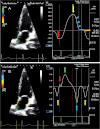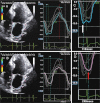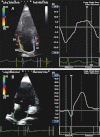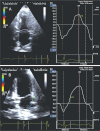New echocardiographic techniques for evaluation of left atrial mechanics
- PMID: 22909795
- PMCID: PMC3598416
- DOI: 10.1093/ehjci/jes174
New echocardiographic techniques for evaluation of left atrial mechanics
Abstract
Until recently the left atrium had been subordinate to the left ventricle, but cardiologists now recognize that left atrial (LA) function is indispensable to normal circulatory performance. Transthoracic two-dimensional (2D) and Doppler echocardiography can elucidate parameters of LA function non-invasively. Yet, with the advent of 2D speckle-tracking echocardiography, we are able to detect early LA dysfunction even before structural changes occur. This is pivotal in some common disease states, such as atrial fibrillation, hypertension, and heart failure, in which LA deformation parameters can influence clinical management. However, a unique standardized technique to investigate LA deformation needs to be validated.
Figures













Comment in
-
Left atrial reservoir phase: deformation analysis.Eur Heart J Cardiovasc Imaging. 2013 May;14(5):500-1. doi: 10.1093/ehjci/jes316. Epub 2013 Jan 11. Eur Heart J Cardiovasc Imaging. 2013. PMID: 23313917 No abstract available.
-
Left atrial mechanics: new echocardiographic techniques for function evaluation: our reply.Eur Heart J Cardiovasc Imaging. 2013 May;14(5):500. doi: 10.1093/ehjci/jes317. Epub 2013 Jan 11. Eur Heart J Cardiovasc Imaging. 2013. PMID: 23720826 No abstract available.
References
-
- Ho SY, Anderson RH, Sánchez-Quintana D. Atrial structure and fibres: morphologic bases of atrial conduction. Cardiovasc Res. 2002;54:325–36. - PubMed
-
- McAlpine WA. Heart and Coronary Arteries: an Anatomical Atlas for Clinical Diagnosis, Radiological Investigation, and Surgical Treatment. Verlag, Berlin: Springer; 1975. pp. 58–9.
-
- Markides V, Schilling RJ, Ho SY, Chow AW, Davies DW, Peters NS. Characterization of left atrial activation in the intact human heart. Circulation. 2003;107:733–9. - PubMed
-
- Dabrowska-Kugacka A, Lewicka-Nowak E, Ruciński P, Zagozdzon P, Raczak G, Kutarski A. Atrial electromechanical sequence and contraction synchrony during single- and multisite atrial pacing in patients with brady-tachycardia syndrome. Pacing Clin Electrophysiol. 2009;32:591–603. - PubMed
-
- Lang RM, Bierig M, Devereux RB, Flachskampf FA, Foster E, Pellikka PA, et al. Recommendations for chamber quantification: a report from the American Society of Echocardiography's guidelines and standards committee and the chamber quantification writing group, developed in conjunction with the European Association of Echocardiography, a branch of the European Society of Cardiology. J Am Soc Echocardiogr. 2005;18:1440–63. - PubMed
Publication types
MeSH terms
Grants and funding
LinkOut - more resources
Full Text Sources
Medical

